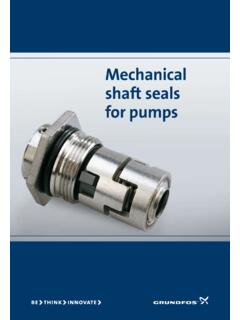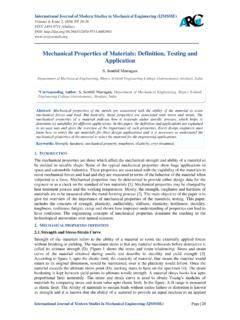Transcription of Structure and Mechanical Properties of Materials
1 Structure and Mechanical Properties of MaterialsIntroduction to Material Properties New Focus on: Fundamental information on the bulk Properties of biomaterials Basic level to enable understanding of metallic, polymeric, and ceramic substrates In the next few classes we will cover: Crystal Structure Stress-strain behavior Creep, fracture, fatigue, and wear of materialsThe 14 Bravais LatticesSolidification of a Polycrystalline MaterialGrain BoundariesThe Three Common Types of MaterialsIntroduction to Carbon PolymersThe unit at the base ofCarbon Chains3-D Representation of a chain of single bonded carbonsCarbon chains can only rotates in specific waysIntroduction to Carbon PolymersBranching in PolymersCross-Linking in PolymersMulty-Component PolymersMulti-Component PolymersMechanical Properties of MaterialsFundamentals of Elastic BehaviorBasic Types of Loading and DeformationsDefinition of StressTensile StressShear StressDefinition of StressDefinition of StrainTensile
2 StrainLateral StrainShear StrainDefinition of StrainPoisson s RatioThe stress-strain curve does not show an important feature of plastic deformation: -A contraction perpendicular to the extension caused by a tensile stressDefinitions of Elastic ConstantsBasic Definition of Tensile PropertiesTensile Properties and Their MeasurementYoung s Modulus over DensityStrength over DensityNon-Linear Deformation of Lumbar VertebraNon-Linear Deformation of Lumbar VertebraUltimate load under Tension/CompressionStresses on Bone Under Different Types of LoadingStresses on Bone Under Different Types of LoadingPrincipal Stresses and Ski Injury in Tibia due to TorqueMechanical Properties of TissuePlasticity of TissueSub-Failure InjuryMaterial Properties ofBiological/Implant MaterialsBasic
3 Definition of ToughnessSummary and Concluding Remarks This class presents an introduction to the Structure and Properties of Materials A simple introduction to amorphous and crystalline Structure was presented This was followed by some basic definitions of stress, strain & Mechanical Properties The Mechanical Properties of soft and hard tissue were then introduced Balance of Mechanical Properties is key for desig






